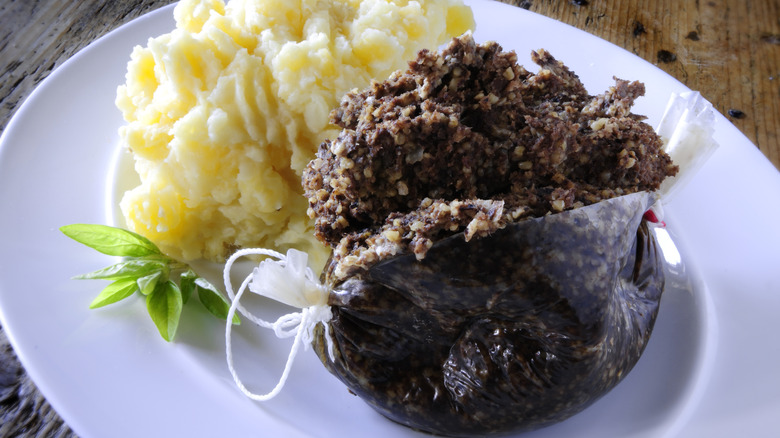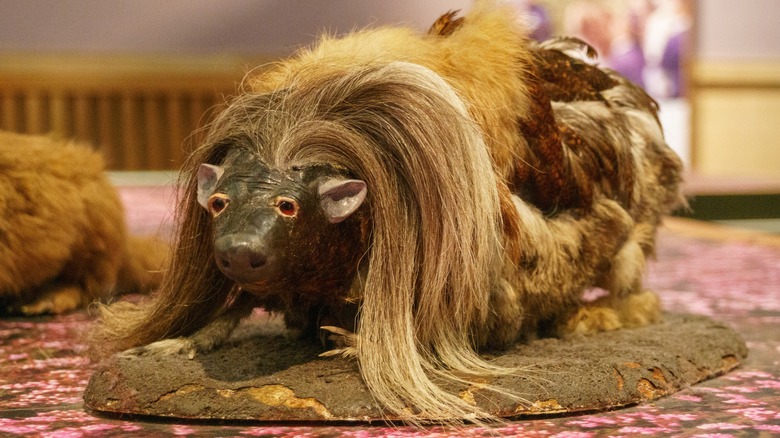Here's The Trick To Appreciating Haggis, Scotland's Most Offbeat Delicacy, Per Rick Steves
We may receive a commission on purchases made from links.
The advice travel guru Rick Steeves offers to anyone intent on sampling Scotland's national dish: Just don't think about it. And he's not wrong. Let's face it, there are plenty of familiar, everyday foods most of us would avoid if we knew exactly what we were eating. But, who thinks about how sausage is made when they're tucking into a hearty American breakfast? And don't even get us started on gummy bears. In an article on his website, Steves writes, "The trick to appreciating such dishes is to think of how it tastes, not what it's made of — just like with caviar or hot dogs." He considers it an offbeat delicacy for adventurous foodies.
By most accounts, haggis tastes pretty darn good. So what's the fuss? We're not sure how, where, or when, but someone somewhere along the line decided to share a graphic account of what goes into making haggis. It's not a pretty process and it may not even have originated in Scotland. Regardless of its exact provenance, food historians tend to agree that haggis was conceived by peasant cooks as a way to ensure no part of a sheep would go to waste. After the animal was butchered, they gathered leftover scraps — heart, liver, and lungs — minced and mixed them with oats, suet, and seasonings then packed the blend into the sheep's stomach lining and sewed it securely shut. The entire dumpling was then either steamed or boiled.
How to eat haggis
Steves has built a career around his travel philosophy of embracing cultural differences and learning from personal experiences, and that includes food. Once you get past any initial hesitation about what's in haggis, you may discover it tastes better than you expected. By and large, people tend to notice the texture first, and it's not unpleasant. Kind of like a coarse sausage. Depending on the recipe, you'll likely pick up hints of pepper, onions, coriander, nutmeg, sage, and mace.
For an authentic experience, it's best to sample haggis along with its traditional side dishes. Think about it: What would Thanksgiving dinner be without dressing and cranberry sauce? In Scotland, haggis is usually plated with mashed neeps and tatties. (That's turnips and potatoes for those of us unfamiliar with Scottish culinary jargon.) Then there's the whisky cream sauce, made of whisky, cream, butter, stock, and mustard. But the traditional way to serve haggis isn't the only way to savor Scotland's national dish. Modern-day preparations run the gamut from haggis pizza and nachos to gnocchi and loaded fries.
Then there's the royal Balmoral chicken. Although no one's quite sure who invented the haggis-stuffed chicken dish, it was likely named for the gothic Balmoral Castle, the British royal family's vacation home in Scotland. It may come as a surprise, but there's also a vegetarian option. Around 40 years ago, Macsween, one of the premier haggis makers in Scotland, came up with a recipe for plant-based haggis. While the actual recipe is a well-kept secret, some include ground legumes and nuts to mimic the original's meaty texture along with oatmeal, onion, and traditional seasoning. What prompted the creation of vegetarian haggis? It all goes back to Robert Burns, the 18th-century Scottish poet who wrote a now-famous ode to haggis.
A Scottish poet's ode to haggis
Although the original manuscript for the heartfelt "Address to Haggis" has been lost to time, other works by Burns are part of a collection held by the National Trust of Scotland in the book-lovers' city of Edinburgh, a municipality known for its medieval castle and vibrant arts community. The ode Burns penned in 1787 catapulted the simple peasant dish to a place of honor among proud Scotsmen. In 1801, on the fifth anniversary of his death, Burns' friends gathered to celebrate their late friend during an evening of revelry that included his favorite dish and a recitation of the lyrics he wrote in its honor. The celebration was such a success that the friends continued the tradition every year on January 25 — and it's still going strong, on a worldwide basis, more than two centuries later.
Burns Night, as it's known around the world, typically includes a tribute to haggis. The haggis is presented to the addresser (a poet standing in for Burns) during a piper-led procession. The addresser then recites all eight verses of Burn's tribute poem before the haggis is served. Now, about that vegetarian haggis. In 1984, a Burns Night poet, Tessa Ranford, challenged Macsween to create a plant-based option. And the rest, as they say, is history. Vegetarian or not, making haggis can be a lot of work. Pre-made canned varieties of haggis are available. In the U.K., look for haggis in specialty stores including Fortnum & Mason, Harrods, and Selfridges.
We'd be remiss if we didn't address one persistent rumor about haggis. Contrary to fairy tales about its genesis, haggis is not a small furry animal with uneven legs that lives in the Scottish Highlands. The name of the dish is believed to be a derivation of the Scottish word "hag" which means to chop.


